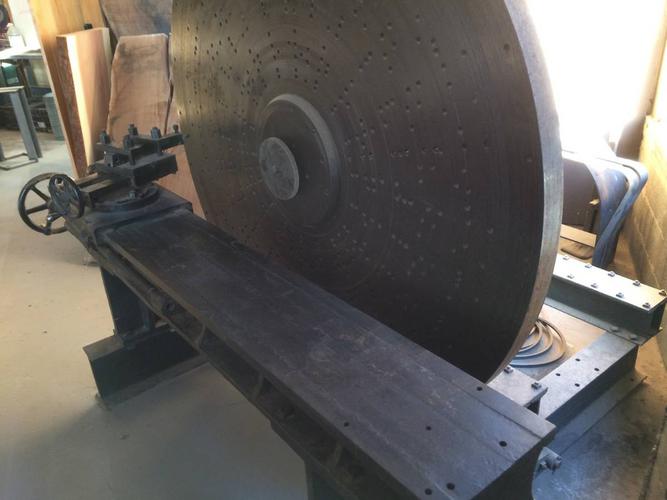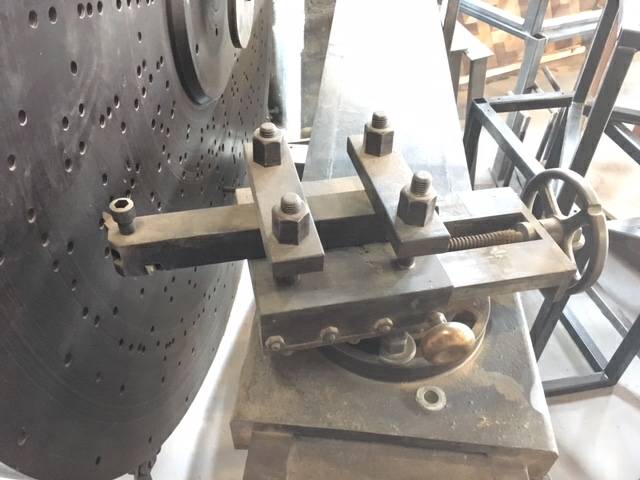Results 1 to 10 of 15
-
12-24-2016, 07:11 PM #1The First Cut is the Deepest!


- Join Date
- Feb 2010
- Location
- Upper Middle Slobovia NY
- Posts
- 2,737
Thanked: 481 Not Razor related, but really want to know about this lathe!
Not Razor related, but really want to know about this lathe!
I was looking for a small metal lathe to make parts with, and found this on Craigslist, and I am super curious if anybody here might know what it was for!
MY urge is to lay it on its side and use it to lap my stones flat! =P
Copy reads "made in 1917 72" diameter with an 87" bed " and calls it a 'Pattern Lathe"
My best guess is it was for truing wheels for locomotives. Any old machinist here have any ideas?


-
12-24-2016, 10:31 PM #2

interesting! we have some old machinists around here (Geezer) he might show up and give some info. i'd be interested to know too.
-
12-24-2016, 10:34 PM #3

Send Benz a PM, here;
http://straightrazorpalace.com/members/benz.htmlOur house is as Neil left it- an Aladdins cave of 'stuff'.
Kim X
-
12-24-2016, 10:48 PM #4Senior Member



- Join Date
- Oct 2010
- Posts
- 26,211
Thanked: 8626
Looks like something to resurface flywheels. Looks plenty heavy!
-
12-25-2016, 12:40 AM #5Senior Member

- Join Date
- Dec 2015
- Location
- North Dakota
- Posts
- 1,455
Thanked: 250
-
12-25-2016, 02:10 AM #6
-
12-25-2016, 02:13 AM #7Senior Member

- Join Date
- Dec 2015
- Location
- North Dakota
- Posts
- 1,455
Thanked: 250
Do you have any views of the backside? A good place to search for information on this particular machine is practicalmachinist.com
-
12-25-2016, 06:14 AM #8Previously lost, now "Pasturized"


- Join Date
- Oct 2005
- Location
- Winnipeg Manitoba Canada
- Posts
- 1,333
Thanked: 351
It looks like a large faceplate lathe. The faceplate has all manners of hole patterns for bolting portions of a circle like parts to it. Such parts might be used as bolt on counterweights for large engines, steam engine flywheels and the like. Each different size of part would have it's own hole pattern for bolts and depending on the size of the flywheel it was meant for, it would have to be bolted to the exact same diameter as the flywheel for machining.
As both feed axis are hand powered, no fancy turning would have been possible, unlike most engine lathes today that have powered/geared feeds that can accurately turn threads and such.
This type of lathe would not be used today as CNC mills could handle such work with ease. In mass production, CNC lathe/mill combos can turn a flywheel with counterweights in one piece without breaking a sweat, similar to how they do engine crank shafts.
I'm going to guess that the hole patterns in the face plate is what gives the lathe it's name."Aw nuts, now I can't remember what I forgot!" --- Kaptain "Champion of lost causes" Zero
-
01-02-2017, 04:24 AM #9

As Benz said, it is a pattern lathe, but maybe more information is needed for those non machinist or non metal casters.
A pattern lathe is used to make the wooden pattern of a metal part that is to be sand casted. The wooden pattern is made and banged into the sand to make the impression for the metal part. Once the impression is made with the wooden pattern, the wooden pattern is removed, the sand form sides are joined, and liquid metal is poured into the hollow space in the sand made by banging the wooden pattern into it.
Greatly simplified, but that is basically how the casting technique works and why a pattern lathe is used.Some people never go crazy. What truly horrible lives they must lead - Charles Bukowski
-
The Following User Says Thank You to criswilson10 For This Useful Post:
Benz (01-02-2017)
-
01-02-2017, 07:12 PM #10Previously lost, now "Pasturized"


- Join Date
- Oct 2005
- Location
- Winnipeg Manitoba Canada
- Posts
- 1,333
Thanked: 351
Interesting..... I looked at the cutter and it looked to me like a high speed steel cutter ground for cutting metal and not wood, but I could be wrong. Strangely enough, I've been wrong before.

Second, the maximum hight of a ring pattern turned on that faceplate might be 6" - 8". I'm struggling to imagine what would be cast like that, except for perhaps collars for sewer lids and safe doors or some such? The raised centre portion of the face place precludes something solid and full thickness in the centre.
Then again, many patterns for sand casting are made modular and pieced together before making the mold. I've only been in one foundry some 40 years ago in Norway, the molds were so large they used pits in the ground to make them.
It's a unique lathe for sure, and since my posting, I've tried to find references to my initial thoughts, but I have had zero luck.
The odd thing is, that as far as I know, wood patterns were turned with hand held chisels and scrapers using a tool rest. Even the Metal Spinner guys mostly use wood scrapers and a tool rest on a lathe for shaping the wood patterns they spin metal on. The face plate on this lathe is quite thick for turning wood patterns... but it may be a "one off" lathe unless it has manufacturers stamp and model number?
I never worked in the casting industry and while my memory is going "soft", I don't recall seeing such a lathe at the foundry I visited. I do remember they considered any steel plate less than 6" thick to be sheet metal, and 6" thick plates were cold rolled into pipes by one man using a crane and vertical rollers and later the seam was welded in one pass with a motorized crawling arc welder. Castings of cylinders for large ships were allowed to "season" in the outdoor yard for 10 years before being turned to size.
Regards
Kaptain "I may be loosing it" Zero"Aw nuts, now I can't remember what I forgot!" --- Kaptain "Champion of lost causes" Zero
-
The Following User Says Thank You to kaptain_zero For This Useful Post:
Magpie (01-03-2017)


 12Likes
12Likes LinkBack URL
LinkBack URL About LinkBacks
About LinkBacks






 Reply With Quote
Reply With Quote


